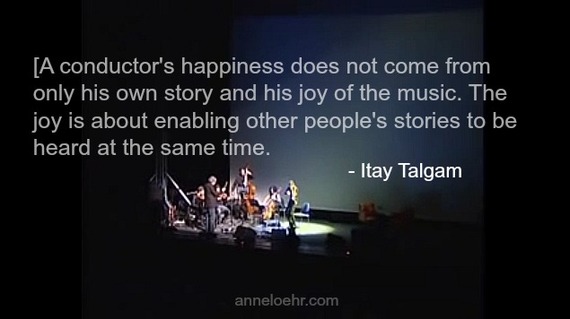I was completely startstruck. I couldn't believe I was given the opportunity to interview him and I truly didn't know what to ask. We'd never met, but I've used his profound TED talk many times when teaching and coaching.
I'm talking about Itay Talgam, conductor, business consultant, speaker, and author of The Ignorant Maestro: How Great Leaders Inspire Unpredictable Brilliance. Itay uses his knowledge of leading an orchestra to provide unique insight into business leadership. Because he is passionate about music, his perspective touches on elements of leadership not easily analyzed in the business world.
I pulled myself together and came up with questions for Itay having to do with leadership and organizational culture, but the conversation took on a life of its own. When Itay speaks of the orchestra--conductors, players, and orchestral dynamics--his perspectives translate beautifully to the business world. I'd like to share three of those perspectives with you today.
Itay's "First" and What He Learned
Let's start with a little back story. Itay's first experience with conducting happened when he established a community orchestra in Jerusalem. This was a big deal because a community orchestra didn't exist in Jerusalem at that time so people who wanted to play music with others previously had no outlet. Therefore, the opportunity to play in an orchestra attracted people of all kinds of people--young, old, diplomats, Arabs, Jews--you get the (very diverse) picture.
The first concert this orchestra performed was in the Old City of Jerusalem, which included a very unlikely audience. Itay joked that they played "something that resembled Beethoven."
What Itay learned through this experience could be considered sacrilegious in the classical music world and shaped his future: he cared more about relationships with the community musicians than he cared about his relationship with music.
This story is a good lead into the first leadership insight I'd like to share with you. That is--the best leaders develop their talent and team first.
1. The Best Leaders Develop Their Talent and Teams First
Itay shared the sad but true reality that after five or ten years, most professional orchestra musicians hate what they do. And they see no way out. Why?
The answer starts with love. Players go into music out of love. It is not a career choice for those who want to get rich. Yet even the best players will only be in the sixteen chair of their section. (Each instrument section has ranked chairs, based on your musical abilities. First chair is the highest rank.) While sixteen is a well respected position, it is still number sixteen. Once the musicians reach their dream of joining an orchestra, they realize they have no creativity or say in the music that is chosen or how it is played. They may have to spend their day playing music that they don't love. And when the music they do love, say Mozart, is chosen by the conductor, the conductor may not understand Mozart, which makes it frustrating to play. In other words, the musician's love of music makes their current reality horrible.
Talent: Use It Or Lose It
We see this happen in work organizations all the time. For example, Jair accepts a work offer, excited to contribute to the organization. He knows the competition was steep to get the position so he feels confident the organization will be interested in what he can contribute. Except no one really pays attention to the Jair's ideas, since he's the 'new hire'. Instead, he's buried in administrative tasks unrelated to his area of interest, and his manager gives him no feedback or recognition. He ends up feeling like a voiceless cog on a wheel and starts to hate not only the organization he works for but also the industry as a whole. Jair's career path is totally derailed and he eventually joins another organization never having the opportunity to make a sliver of an impact at his first job. What a waste of talent.
Leaders have to focus on developing their talent from day one, especially with Gen Y. Members of an organization are all individuals with human needs and desires. Don't let them feel invisible. Don't take away their voice. Don't take away their interest (or love) in what they are doing for work. If those things are taken away, at best you will end up with a disengaged employee who has no motivation to contribute on a meaningful level. At worst you'll lose the talent completely. That can be a blow to your organizational culture and quite expensive considering it costs 2.5 a person's salary to replace them. In fact, leaders become the limiting force of the organization.
2. Leaders Must Not Become the Limiting Force of the Organization
Looking at a conductor is a great way to understand what it means to "get out of your own way." Itay explains that some conductors train orchestras like they are training dogs for a circus. The musicians learn to play on direct command with no room for interpretation. When a conductor does this, he has become the limit of the group, when in fact the players can do better than the limit put upon them. The key to success is to provide enough structure and direction for the players that they are able to change and mold the idea to become something different. In this way the orchestra can develop their own sound, just as businesses can develop an organic culture.
3. Leaders Must Connect People to the Process
Finally, Itay believes that leaders have to supply enough interest and structure to make people want to take part in the organizational vision. The next step is to let that vision serve as a platform for teams to use their talents and voices while executing the vision in a way that is unique. When connecting people to the process and letting them see where the process takes them, something entirely new will be created - something that the leader did not know in advance. Itay puts great weight on the ability to lead and yet be surprised by what develops with the joint effort of the organization.
Leaders, Get Out of Your Own Way
This can be difficult for leaders who feel very committed to their ideas and how those ideas should be executed. Their vision can reach greater heights with the innovation that comes from employees. Yet, that means leaving space for failure too. Are you willing to let your employees fail? If not, you might want to think about the repercussions on your organizational culture and teams.
Just as an orchestra is made up of musicians who all contribute their own sound in order to create a more complex experience, individual employees contribute to the total impact of the organization. Just as there is a dialogue between the player and the conductor, the player and the audience, and the audience and the conductor, there is a dialogue between the employees and the leader, the employees and the consumers, the consumers and the leaders. It is in these dialogues that culture is created. And these dialogues are what allow the vision of the business leader or conductor to come to life not only for the organization, but for those they lead.
I'd love to hear your thoughts on the comparison between an orchestra conductor and business leader. If the conductor had only one tip to give a business leader, what would it be? And how about the opposite? Tell me your ideas in the comment section below, via email, or on Twitter.
Learn more about Itay here on his website.
Anne Loehr is a sought after keynote speaker, writer, consultant and trainer. She helps leaders in large organizations connect their everyday decisions today to the future workplace. Her end goal is to help organizations retain their top talent and not only survive, but thrive. To learn more about Anne, check out www.anneloehr.com or follow her on Twitter.




